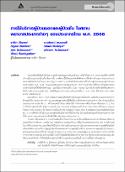บทคัดย่อ
ประเทศไทยได้เริ่มดำเนินโครงการหลักประกันสุขภาพถ้วนหน้าอย่างจริงจังตั้งแต่ พ.ศ. 2545 ส่งผลให้การเข้าใช้บริการผู้ป่วยนอกและผู้ป่วยในเพิ่มมากขึ้น การศึกษานี้มีวัตถุประสงค์เพื่อศึกษาการใช้บริการด้านสุขภาพของประชากรไทยตามสิทธิหลักประกันสุขภาพภาครัฐประเภทต่างๆ และปัจจัยที่ส่งผลต่อการใช้บริการผู้ป่วยนอกและผู้ป่วยในของประชากรไทย พ.ศ. 2558 จำแนกตามสถานพยาบาลประเภทต่างๆ ทำการวิเคราะห์การใช้บริการด้านสุขภาพของประชากรไทยโดยใช้สถิติเชิงพรรณนา และใช้แบบจำลองโลจิต (logit model) ในการวิเคราะห์ปัจจัยที่ส่งผลต่อการใช้บริการผู้ป่วยนอกและผู้ป่วยใน โดยใช้ข้อมูลการสำรวจอนามัยและสวัสดิการ พ.ศ. 2558 ที่ดำเนินการสำรวจโดยสำนักงานสถิติแห่งชาติ
ผลการศึกษา พบว่า ประชากรไทยส่วนใหญ่มีสิทธิหลักประกันสุขภาพถ้วนหน้า แต่ยังมีความแตกต่างระหว่างลักษณะทั่วไป สถานภาพการทำงาน และเศรษฐฐานะของผู้มีสิทธิในการรักษาพยาบาลแบบต่างๆ อัตราป่วยแบบผู้ป่วยนอกของประชากรไทย คือ 3.1 ครั้งต่อคนต่อปี ส่วนมากเลือกวิธีการรักษาโดยการซื้อยากินเอง คือร้อยละ 27.2 ส่วนการใช้บริการผู้ป่วยในนั้น มีอัตราการนอนโรงพยาบาล 0.06 ครั้งต่อคนต่อปี ส่วนมากรับการรักษาที่โรงพยาบาลชุมชน (ร้อยละ 39.6) รองลงมา คือ โรงพยาบาลทั่วไป/โรงพยาบาลศูนย์ (ร้อยละ 38.7) ส่วนโรงพยาบาลเอกชนมีสัดส่วนร้อยละ 11.3 การใช้บริการทั้งผู้ป่วยนอกและผู้ป่วยในมีหลายปัจจัยที่เกี่ยวข้อง ไม่ว่าจะเป็นลักษณะทั่วไปของประชากร โรคเรื้อรัง และความแตกต่างระหว่างสิทธิสวัสดิการด้านสุขภาพประเภทต่างๆ
จากผลการศึกษาดังกล่าว ประชาชนเลือกซื้อยากินเองจำนวนมากเกือบหนึ่งในสามของจำนวนทั้งหมด เพื่อความปลอดภัยในการบริโภคยา ควรมีมาตรการส่งเสริมความปลอดภัยในการซื้อยากินเองของประชาชน เช่น การให้ความรู้ในการใช้ยาแก่ประชาชน และ พัฒนาให้มีกลไกการรับรองร้านยาคุณภาพ นโยบายของกระทรวงสาธารณสุขที่มุ่งเน้นส่งเสริมและพัฒนาหน่วยบริการปฐมภูมิ เช่น ทีมหมอครอบครัว การดูแลผู้ป่วยที่บ้าน และระบบการดูแลผู้ป่วยในระยะยาว จะช่วยลดช่องว่างในการใช้บริการของผู้ป่วยกลุ่มเปราะบาง เช่น คนยากจนและผู้สูงอายุ และช่วยลดภาระในการเข้ารับการรักษาพยาบาลของผู้ป่วยด้วยโรคเรื้อรัง สำหรับผู้ไม่มีสิทธิสวัสดิการรักษาพยาบาล รัฐควรขยายความครอบคลุม เพื่อให้สามารถเข้าถึงบริการได้โดยไม่มีภาระด้านค่าใช้จ่าย และลดความเหลื่อมล้ำระหว่างสวัสดิการด้านสุขภาพ
บทคัดย่อ
Advancement of Universal Health Coverage in Thailand since 2002 increased access to both
outpatient (OP) and inpatient (IP) services. This study aimed to analyze the utilizations of government
health insurance schemes and also the factors affecting access to outpatient and inpatient services in
2015. Based on the 2015 Health and Welfare Survey data, descriptive and logit model was performed
to analyze individual utilization of outpatient and inpatient and the factors determining the heath care
utilization.
Results demonstrated that universal health coverage scheme covered the majority of Thai
population. However, the general characteristic, employment and economic status of beneficiaries
differed across different schemes. The illness rate for ambulatory care was 3.1 episodes per capita per
year. Over-the-counter medicines had the biggest share around 27.2 percent, while the hospitalization
was 0.06 admission per capita per year. Most of them were admitted at community hospital and
general hospital (39.6 percent and 38.7 percent respectively), while the hospitalization in private
hospital was only 11.3 percent. In addition, there are some other factors that affected the utilization
of both outpatient and inpatient services such as household characteristic, chronic diseases and the
variation of benefit package of each scheme.
Many people chose to buy drug (around one-third of total treatments). It is important to
establish safety measures through awareness on rational use of drugs and develop a mechanism to
ensure drug quality. Policy maker should strengthen primary care services such as family care team,
home health care and long-term care to reduce the utilization gap in vulnerable groups especially the
poor and elderly and reduce financial burden from medical treatment of patient with chronic disease.
Moreover, government should expand the coverage to uninsured group to increase access to health
care services without financial burden to reduce the gap among health insurance groups.


